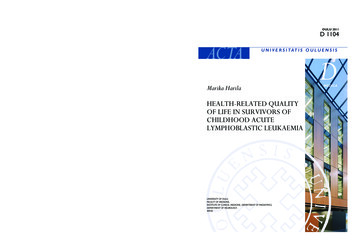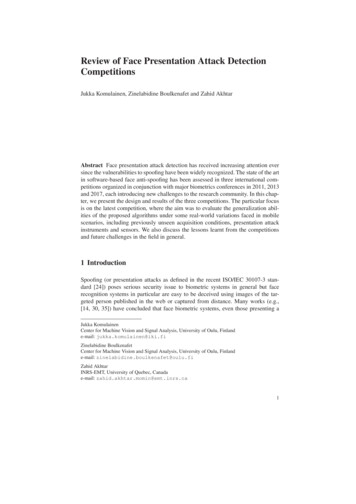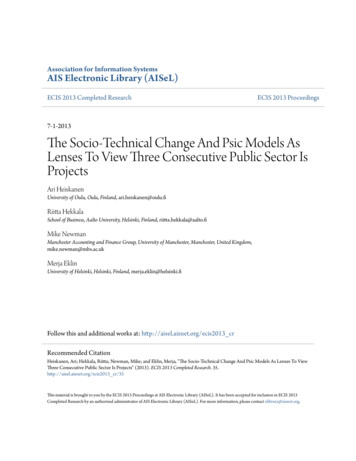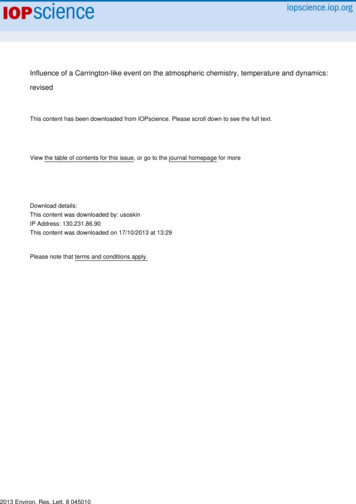
Transcription
D 1104OULU 2011U N I V E R S I T Y O F O U L U P. O. B . 7 5 0 0 F I - 9 0 0 1 4 U N I V E R S I T Y O F O U L U F I N L A N DU N I V E R S I TAT I SS E R I E SSCIENTIAE RERUM NATURALIUMSenior Assistant Jorma ArhippainenHUMANIORALecturer Santeri PalviainenTECHNICAProfessor Hannu HeusalaACTAU N I V E R S I T AT I S O U L U E N S I SMarika HarilaE D I T O R SMarika HarilaABCDEFGO U L U E N S I SACTAA C TAD 1104HEALTH-RELATED QUALITYOF LIFE IN SURVIVORS OFCHILDHOOD ACUTELYMPHOBLASTIC LEUKAEMIAMEDICAProfessor Olli VuolteenahoSCIENTIAE RERUM SOCIALIUMSenior Researcher Eila EstolaSCRIPTA ACADEMICADirector Sinikka EskelinenOECONOMICAProfessor Jari JugaEDITOR IN CHIEFProfessor Olli VuolteenahoPUBLICATIONS EDITORPublications Editor Kirsti NurkkalaISBN 978-951-42-9462-4 (Paperback)ISBN 978-951-42-9463-1 (PDF)ISSN 0355-3221 (Print)ISSN 1796-2234 (Online)UNIVERSITY OF OULU,FACULTY OF MEDICINE,INSTITUTE OF CLINICAL MEDICINE, DEPARTMENT OF PAEDIATRICS,DEPARTMENT OF NEUROLOGY;VERVEDMEDICA
ACTA UNIVERSITATIS OULUENSISD Medica 1104MARIKA HARILAHEALTH-RELATED QUALITY OFLIFE IN SURVIVORS OF CHILDHOODACUTE LYMPHOBLASTICLEUKAEMIAAcademic dissertation to be presented with the assent ofthe Faculty of Medicine of the University of Oulu forpublic defence in Auditorium 12 of Oulu UniversityHospital, on 17 June 2011, at 12 noonU N I VE R S I T Y O F O U L U , O U L U 2 0 1 1
Copyright 2011Acta Univ. Oul. D 1104, 2011Supervised byDoctor Arja Harila-SaariProfessor Marjatta LanningReviewed byDocent Tuula LönnqvistDocent Krister K. BomanISBN 978-951-42-9462-4 (Paperback)ISBN 978-951-42-9463-1 N 0355-3221 (Printed)ISSN 1796-2234 (Online)http://herkules.oulu.fi/issn03553221/Cover DesignRaimo AhonenJUVENES PRINTTAMPERE 2011
Harila, Marika, Health-related quality of life in survivors of childhood acutelymphoblastic leukaemia.University of Oulu, Faculty of Medicine, Institute of Clinical Medicine, Department ofPaediatrics, Department of Neurology, P.O. Box 5000 , FI-90014 University of Oulu , Finland;Verve, P.O. Box 404 , FI-90101 Oulu , FinlandActa Univ. Oul. D 1104, 2011Oulu, FinlandAbstractLeukemia treatment has been implicated to be responsible for a diversity of long-term adverseeffects (Pui 2008), which can occur even years after diagnosis and can seriously impair survivors’performance status and quality of life (Campbell et al. 2007, Zeltzer et al. 2008). The aim of thepresent work was to assess health-related quality of life in long-term survivors of acutelymphoblastic leukemia (ALL), and to find out whether vocational rehabilitation can promote thecoping at work of young people who take part in a training intervention or help them findemployment.Neuropsychological testing was performed on 64 survivors. Cranial irradiation had beenadministered to 44 of the survivors, while 20 survivors had been treated solely with chemotherapy.A control group consisted of 45 healthy young adults. We found that young adult survivors ofchildhood ALL treated with cranial irradiation had clear progressive deficits in theirneurocognitive functioning at a mean of 20 years after diagnosis compared with healthy controls.Non-irradiated ALL survivors performed significantly better, but even they had statisticallysignificant impairments in some of the neuropsychological test scores compared with the controls.Rand-36-Item health Survey (RAND-36) was used to assess subjective HRQoL, depressivesymptoms were assessed with Beck Depression Inventory (BDI-21), and mental distress withGeneral Health Questionnaire (GHQ-12) in 74 survivors of ALL. The control group consisted of146 healthy young adults selected from local population registry. ALL survivors showed goodHRQoL scores in comparison to the control group. Patients who had been treated for an ALLrelapse and had received the most intensive chemo- and radiotherapy had significantly higherscores on mental health and vitality than the controls. Survivors of ALL report fewer depressivesymptoms and equal mental well-being compared to healthy controls. Nine out of 63 survivorswere selected for rehabilitation based on their occupation and psychosocial difficulties. Theoccupational rehabilitation course improved physical fitness and decreased overweight in longterm survivors of ALL, but impaired their HRQoL. Our findings support the idea that ALLsurvivors’ subjective experience of well-being is possibly affected by a repressive adaptive style.Keywords: acute lymphoblastic leukemia, childhood cancer survivor, depressivesymptoms, follow-up, health-related quality of life, mental distress, neurocognitivefunctioning, occupational rehabilitation
Harila, Marika, Terveyteen liittyvä elämänlaatu lapsuusiässä sairastetun akuutinlymfaattisen leukemian jälkeen.Oulun yliopisto, Lääketieteellinen tiedekunta, Kliinisen lääketieteen laitos, Lastentaudit,Neurologia, PL 5000, 90014 Oulun yliopisto; Verve, PL 404, 90101 OuluActa Univ. Oul. D 1104, 2011OuluTiivistelmäLeukemiahoidoilla on todettu olevan pitkäaikaisvaikutuksia (Pui 2008), jotka voivat ilmetä jopavuosia diagnoosin jälkeen heikentäen sairaudesta selvinneiden toimintakykyä ja elämänlaatua(Campbell et al. 2007, Zeltzer et al. 2008). Tämän tutkimuksen tavoitteena oli arvioida akuutista lymfaattisesta (ALL) leukemiasta selvinneiden terveyteen liittyvää elämänlaatua pitkällä aikavälillä sekä selvittää, voidaanko ammatillisen kuntoutuksen avulla edistää interventioon osallistuneiden työssä selviytymistä tai työllistymistä.Neuropsykologiseen tutkimukseen osallistui 64 ALL pitkäaikaisselviytyjää. Heistä 44 olisaanut pään alueen sädehoitoa ja 20 pelkästään solunsalpaajahoitoa. Verrokkiryhmässä oli 45tervettä nuorta aikuista. Havaitsimme, että lapsuudessa pään alueen sädehoitoa saaneilla ALLselviytyjillä oli verrokkeihin verrattuna selkeitä progressiivisia muutoksia neurokognitiivisessatoimintakyvyssä keskimäärin 20 vuotta diagnoosista. Ne, jotka eivät olleet saaneet sädehoitoasuoriutuivat huomattavasti paremmin, mutta heilläkin havaittiin tilastollisesti merkittäviä puutoksia joillakin neuropsykologisten testien osa-alueilla verrokkeihin verrattuna. 74 entisen ALLpotilaan terveyteen liittyvää elämänlaatua (HRQoL) mitattiin Rand-36 -mittarilla, masennusoireita Beckin masennustestillä (BDI-21) ja henkistä hyvinvointia General Health Questionnaire mittarilla (GHQ-12). Verrokkiryhmäksi valittiin väestörekisteristä 146 tervettä nuorta aikuista.ALL-ryhmässä tutkittavien terveyteen liittyvää elämänlaatua mittaavat pisteet olivat hyvät verrokkiryhmään verrattuna. Ne potilaat, joita oli hoidettu leukemian uusiutumisen takia ja jotkaolivat saaneet intensiivisintä solunsalpaaja- ja sädehoitoa saivat huomattavasti paremmat pisteetpsyykkisen hyvinvoinnin ja vitaalisuuden osa-alueilla kuin verrokit. ALL -selviytyjät raportoivatvähemmän masennusoireita, ja he arvioivat psyykkisen hyvinvointinsa yhtä hyväksi kuin verrokit. Yhdeksän ALL pitkäaikaisselviytyjää osallistui heille suunnattuun ammatilliseen kuntoutusinterventioon. Ammatillinen kuntoutuskurssi paransi ALL -selviytyjien fyysistä suorituskykyä javähensi ylipainoa, mutta heikensi terveyteen liittyvää elämänlaatua. Tutkimustulokset tukevatajatusta, että repressiivinen adaptaatio voi vaikuttaa lapsuusiän leukemiasta selvinneiden subjektiiviseen hyvinvoinnin kokemukseen.Asiasanat: akuutti lymfaattinen leukemia, ammatillinen kuntoutus, henkinenhyvinvointi, kognitiivinen suoriutuminen, lapsuusiän leukemiasta selvinneet,masennusoireet, seuranta, terveyteen liittyvä elämänlaatu
AcknowledgementsThis thesis work was carried out at the Department of Pediatrics and Adolescenceand the Department of Neurology of Oulu University Hospital. During theprocess of conducting this study, preparing the articles and writing the thesis Ihave received much valuable help, and I would not have been able to do thisresearch alone.I wish to express my most sincere gratitude to Docent Arja Harila-Saari forintroducing me to the world of research. She has always been ready to give meher expert guidance and warm support during this project. She has been anindispensable supervisor and friend. My special gratitude goes to to the lateformer head of Pediatrics and Adolescence Unit, Professor Marjatta Lanning, forproviding the facilities for the study.I also want to thank Professor Kari Majamaa, head of the Department ofNeuology, Oulu University, who supported me in my research project.I also wish to express my sincere gratitude the late former head of theMedical Rehabilitation Unit, Professor Tapani Kallanranta for supportiveguidance and great encouragement.I am also grateful to Ilpo Vilkkumaa Lic.Soc. Sc, who has always been readyto give me his expert guidance.I express my special acknowledgements to my co-author Satu Winqvist Ph.D,for her expert practical guidance and her never-failing encouragement. I also wishto thank my other co-authors, Tomi Niinivirta M.Sc., Jarmo Salo M.D. and EijaHaapala M.Sc, for their valuable contributions. Their contribution and commentshave been crucial for the completion of the original publications.I am also grateful to statistics expert Risto Bloigu M.Sc., for his kind supportin all areas of statistical tasks and his interest in discussing all the challengeswithin the context of scientific research. I also wish to thank computer expertRauno Paavola for technical assistance.I am grateful to Anna Vuolteenaho, M.A., for revision of the Englishlanguage.I want to express my gratitude to Docent Tuula Lönnqvist and Docent KristerBoman for their careful and precise reading of my work, and for their valuablecomments concerning my thesis.I would like to express my gratitude to the participants whose involvement inthe studies made the thesis possible. I would also like to thank Director MattiAnttonen for his support and for giving me the opportunity to carry out the7
rehabilitation intervention associated with this study at the MerikoskiRehabilitation and Research Centre (currently known as Verve). My heartfeltthanks go to the rehabilitation team who implemented the intervention.I especially want to express my thanks to my workmates Laura Vaskivuo,Leena Ervast and Jukka Loukkola, whose flexibility with the work made thisthesis possible.I also want to thank my dear friends for bringing joy to my life and for givingme energy and strength for this research process as well. I wish to express mywarm gratitude to my friend Liisa Paavola for her encouragement and neverending optimism, for our jogging excursions and many other memorablemoments in and outside of work. I owe my special thanks to Marjo Lukkari andSatu Soini for the countless relaxing moments and discussions we have had.I want to express my thanks to my godfather Risto Uusitalo who believed inme and supported me all my life.I am deeply grateful to my mother and my late father for their love andsupport during these years. I also thank my brother Antti for reminding of themeaning of life in general.Finally, my warmest gratitude belongs to my dearest ones: my husband Tapioand my two beloved children Aurora and Aaron, who have had to beunderstanding towards a wife and mother whose thoughts have sometimes beenfar away from the everyday activities of life. Without the loving support of myhusband Tapio this thesis would never have been completed. Aurora and Aaron thanks for reminding me of the most important and valuable things in the world.Thank you all three for making my life so meaningful.This research project has been supported by Nona and Kullervo VäreFoundation, Finland; Foundation for Pediatric Research, Finland; Finnish CancerSociety; Cancer Society of Northern Finland; KEVO funding of Oulu UniversityHospital.Oulu, May8Marika Harila
AbbreviationsALLANCOVABDICCSSCNSCRCRTCTCAEv3Acute Lymphoblastic leukemiaUnivariate analyses of covarianceBeck Depression InventoryChildhood Cancer Survivor StudyCentral nervous systemComplete remissionCranial irradiation therapyThe CommonTerminology Criteria forAdverse Events, Version 3FACT-GFunctional Assessment of Cancer Therapy-GeneralGHQGeneral Health QuestionnaireHRQoLHealth-related quality of lifeEORTCQLQ-30European Organization for Research and Treatment on Cancer QLQ-C-30IQIntelligence quotientMCIDMinimally clinically importance differencePIQPerformance intelligence quotientQOLQualiy of lifeRAND-36 Rand-36-Item health SurveySDRBSocially desirable response biasSF-36Short-Form Health SurveySIIThe Social Insurance InstitutionSNSecond neoplasmSPSSStatistical Package for the Social SciencesVIQVerbal intelligence quotientWHOThe Word Health Organization9
10
List of original publicationsThis list is based on the following publications, which are referred to in the textby their Roman numerals I-IV:IHarila Marika J, Winqvist Satu, Lanning Marjatta, Bloigu Risto & Harila-Saari Arja H(2009) Progressive Neurocognitive Impairment in Young Adult Survivors ofChildhood Acute Lymphoblastic Leukemia. Pediatr Blood Cancer 53: 156–161.II Harila Marika J, Salo Jarmo, Lanning Marjatta, Vilkkumaa Ilpo & Harila-Saari Arja H(2010) High Health-Related Quality of Life Among Long-Term Survivors ofChildhood Acute Lymphoblastic Leukemia. Pediatr Blood Cancer 55: 331–336.III Harila Marika J, Niinivirta Tomi IT, Winqvist Satu & Harila-Saari Arja H (2011) Lowdepressive symptom and mental distress scores in adult long-term survivors ofchildhood acute lymphoblastic leukaemia. J Pediatr Hematol Oncol 33(3): 194–8.IV Harila Marika, Haapala Eija, Vilkkumaa Ilpo & Harila-Saari Arja Efficacy ofoccupational rehabilitation intervention in long-term survivors of acute lymphoblasticleukemia. Manuscript11
12
viations9List of original publications11Contents131 Introduction152 Review of the literature172.1 Epidemiology and etiology of childhood ALL . 172.2 Treatment of childhood ALL. 182.3 Treatment-Related Late-effects . 192.3.1 Physical long-term late effects . 192.3.2 Neuropsychological long-term late effects . 202.4 Health related quality of life (HRQoL) . 242.4.1 Definition. 242.4.2 Measuring HRQoL outcomes . 252.4.3 Model to explain the results of HRQoL . 262.5 Quality of life among ALL survivors . 272.5.1 Social outcomes . 302.5.2 Employment . 312.5.3 Vocational rehabilitation . 323 Aims of the study354 Subjects and methods374.1 Study design . 374.2 Subjects . 404.3 Measure . 414.3.1 Neuropsychological Tests (I) . 424.3.2 Health related quality of life (HRQoL) (II) . 434.3.3 Depressive symptoms and mental distress (III) . 434.3.4 Physical late-effects and physical performance (II, IV) . 444.3.5 The efficacy of the rehabilitation (IV) . 444.4 Statistical methods . 455 Results475.1 Neuropsychological Tests (I) . 4713
5.1.1 Comparison of IQ at the end of Treatment, 5 Years AfterTreatment and a Mean of 17 Years After Completion ofTherap . 505.2 HRQoL . 525.2.1 Physical late-effects . 525.2.2 Emotional and social well-being . 525.2.3 HRQoL in ALL survivors after an average of 20 yearsafter the diagnosis . 535.2.4 The occupational rehabilitation course . 546 Discussion596.1 Discussion on results . 596.1.1 Neuropsychological functioning . 596.1.2 Depressive symptoms, well-being and health-relatedquality of life . 616.1.3 The occupational rehabilitation intervention . 636.2 General discussion . 636.3 Methodological considerations . 656.3.1 Strengths and weaknesses of the study . 656.3.2 Future perspectives . 687 Conclusions69References71Original publications8514
1IntroductionAcute Lymphoblastic leukemia (ALL) is the most common malignancy inchildren. Due to improvement of cancer treatments, today it has a greatlyimproved survival rate of approximately 80% (Gatta et al. 2005;2003, Gustafssonet al. 2000, Harras et al. 1996, NOPHO 2000, Pui & Evans 2006). Treatment ofthe central nervous system (CNS) with cranial irradiation and/or chemotherapyhas been an important factor contributing to the increased survival rate. However,leukaemia treatment has been implicated to be responsible for a diversity of longterm adverse effects. (Pui 2008). CNS treatment has been suspected of beingresponsible for long-term neurocognitive deficits, especially when cranialirradiation is used (Campell et al. 2007, Gaynon et al. 2000, Moore 2005). Theawareness of the harmful effects of cranial irradiation therapy (CRT), especiallyamong young children, has led to the practice of replacing it with CNS-directedchemotherapy. This includes mainly high dosage iv methotrexate and intrathecalmethotrexate (Butler et al. 1994). Whether or not CNS chemotherapy has harmfuleffects on learning, and to what extent, is still controversial.Another major concern is physical, psychosocial and educational deficitsafter cranial irradiation and central nervous system-directed chemotherapy, whichcan occur even years after diagnosis and can seriously impair survivors’performance status and quality of life (Campbell et al. 2007, Hill et al. 1998,Katon & Sullivan 1990, Moore 2005, Schultz et al. 2007, Zeltzer et al. 1997).These deficits may increase the possibility of mental distress and depression. Agrowing number of studies have documented the substantial impact of childhoodcancer treatment which may cause impairments that diminish social functioning,including obtainment or retention of employment (Pang et al. 2008).The number of ALL survivors among young adults is increasing rapidly, andthe need to improve their health-related quality of life is becoming increasinglyimportant and topical issue. Numerous studies have examined these aspects ofchildhood cancer, but the overall quality of life especially in long term survivorsof ALL is not so well studied (Apajasalo et al. 1996, Elkin et al. 1997, Meeske etal. 2005, Pemberg et al. 2005, Stam et al. 2006, Zebrack & Chesler 2002). Theaim in this study was to assess neuropsychological functioning, well-being,depressive symptoms and health-related quality of life and evaluate the efficacyof occupational rehabilitation on employment and coping at work in long-termsurvivors of acute lymphoblastic leukemia.15
16
2Review of the literature2.1Epidemiology and etiology of childhood ALLAcute lymphoblastic leukemia (ALL) is the most common malignancy in children,accounting for 76–80% of all diagnoses of childhood leukemia (Gatta et al.2005;2003, Gustafsson et al. 2000, Harras et al. 1996, Pui & Evans 2006,NOPHO 2000) and approximately 30% of all pediatric malignancies (NOPHO2000).In the Nordic countries the yearly incidence of total childhood cancer hasbeen close to 15–20 cases per 100 000 children under 15 years of age (Gustafssonet al. 2000). In Finland, the yearly incidence of ALL is 50 cases per year. Theincidence of childhood ALL in the Nordic countries has been stable during recentyears (NOPHO 2000). The incidence of acute leukemias in Finland is about 240new patients/year. About 20% of these are children. The peak incidence is seen at2–5 years of age (4–5 patients/100 000). (Engholm et al. 2009). Boys have ahigher leukemia risk than girls, but leukemia diagnosed in the first year of life ismore common in girls than in boys. The incidence of ALL in white children is 3–4 per 100 000, while in African/Americans children it is consistently about half ofthat. (Gurney et al. 1995). There are substantial geographic differences in theincidence of childhood leukemia. In developed countries, the incidence rates forchildhood ALL are two- to four-fold compared to the rates in developingcountries, which could represent differences in environmental factors, geneticfactors and diagnostic accuracy. (Greaves & Alexander 1993). In developedcountries, there is a significant peak in the incidence of childhood ALL betweenthe ages of two and five years, and one subtype, referred to as common ALL,accounts for the high incidence in this age group (Greaves 1999).ALL is a biologically heterogeneous disorder, and its specific etiology isunknown. The causes appear to be multifactorial. Some of the factors involved inthe pathogenesis of ALL include exposure to ionizing radiation or certain drugs,certain chromosome abnormalities and congenital or acquired immunedeficiencies (Golub & Arceci 2002).17
2.2Treatment of childhood ALLThe cure rate for pediatric ALL has improved from 15% in the late 1960s toapproximately 80% today (Gatta et al. 2005, Margolin et al. 2002). Thisimprovement can largely be attributed to the development of more effectivechemotherapeutic regimens in well-designed clinical trials, improvements incombined chemotherapy, diagnostic, surgical and radiotherapeutic techniques,refined supportive care and pediatric cancer studies and services.Acute leukemia is treated with chemotherapy, and the specific treatment isbased on the specific leukemia subtype. ALL treatment protocols also includeCNS-directed therapy in the form of intrathecal administration of methotrexateand/or ARA-C given throughout the systemic chemotherapy. Chemotherapy maybe supplemented with radiation therapy if there is evidence of central nervoussystem (CNS) leukemia or testicular leukemia. (Margolin et al. 2002, Pui 2008).ALL with a poor prognosis or children who suffer a recurrence of ALL may betreated with a bone marrow transplant (Margolin et al. 2002).The duration of treatment varies from 24 to 36 months. A good prognosis isassociated with female gender, age at diagnosis between 2 and 10 years, a lowwhite blood cell count, and an early positive response to treatment. Children witha poor prognosis receive the most aggressive chemotherapy. ALL treatment isdivided into main treatment elements: induction, consolidation and maintenancetherapy. (Margolin et al. 2002).Induction Treatment PhaseThe first phase of ALL treatment is called induction, and it lasts 4–5 weeks. Thegoal of treatment is generally indicated with the term “complete remission” (CR).This is defined as resolution of the sign and symptoms of leukemia, a return tonormal blood and bone marrow values, and leukemia cell kill resulting in fewerthan 5% lymphoblasts in the bone marrow. The basic regimen for inductiontherapy includes at least a glucocorticoid (prednisone, prednisolone, ordexamethasone) and vincristine. (O Reilly et al. 1996, Pui & Evans 1998). Therate of complete remission is 98% in the Nordic countries (Gustafsson et al. 2000).18
Consolidation Treatment phaseThis is the second phase of childhood ALL treatment which begins once theleukemia is in remission. Treatment includes a combination of aggressivemultiagent chemotherapy, and lasts up to 6 months. Chemotherapy consists ofrepeated cycles of drug combinations to prevent the remaining leukemia cellsfrom developing resistance, e.g. methotrexate and 6-mercaptopurine or 6thioguanine, vincristine, L-asparaginase, and/or prednisone. Intrathecal therapy iscontinued at this time. (Margolin et al. 2002, O Reilly et al. 1996).Maintenance therapyIf a patient stays in remission after induction and consolidation therapy,maintenance therapy begins. The goal is to destroy any disease cells that remainso that the leukemia is completely gone. Patients at higher risk may receive moreintensive maintenance chemotherapy and intrathecal therapy. Chemotherapycontinues for 2–2.5 years in girls and 2.5–3 years in boys. (Margolin et al. 2002,O Reilly et al. 1996).2.3Treatment-Related Late-effectsChemotherapy, radiation therapy and stem cell transplantation can cause longterm late-effects, which are secondary conditions that arise following certaincancer treatments. Children are especially sensitive and susceptible to side effectsbecause their tissues are still growing and developing. Side effects varydepending on which drugs are being used, how the drugs are given, and how longthe drug treatment lasts. (Margolin et al. 2002).Awareness of the harmful effects of cranial irradiation therapy (CRT),especially in young children, has led to the practice of replacing it with CNSdirected chemotherapy. This includes mainly high dosage and intrathecalmethotrexate. (Butler et al. 1994, Campell et al. 2007, Gaynon et al. 2000, Moore2005, Mulhern & Palmer 2003, Oeffinger et al. 2006).2.3.1 Physical long-term late effectsReports in the literature indicate that approximately 75% of survivors have one ormore late effects (Cardous-Ubbink et al. 2004). The most common late effects are19
those of growth and development, including linear growth velocity, intellectualdevelopment, and sexual maturation (Adan et al. 2001). A recent stady of adultsurvivors of childhood cancer reported that 62% have at least one chronic healthcondition, with 25% reporting conditions considered to be severe or lifethreatening (Oeffinger et al. 2006), which may not be manifest until many yearslater.The Childhood Cancer Survivor (CCSS) study cohort provides the largest andmost comprehensive assessment of the health of childhood ALL survivors, and inthis analysis spanning more than 20 years from diagnosis adult survivors –including nonirradiated, nonrelapsed ones – reported excessive chronic healthissues and poor health status, with ALL survivors being one of the highest riskgroups for late mortality and morbidity. (Mertens et al. 2001, Mody et al. 2008).These morbidities include second neoplasms, cardiac toxicity, infertility,neurologic toxicity, growth failure and neurocognitive dysfunction. Secondneoplasms (SNs) are one of the most serious and devastating morbiditiesassociated with cancer therapy and have been strongly associated with the use oftherapeutic radiation for treatment of the original cancer. (Jenkinson et al. 2004,Mertens et al. 2001, Mody et al. 2008, Neglia et al. 2001). MacArthur et al.(2007) showed that survivors whose ALL had recurred within 5 years of diagnosishad a 61-fold higher likelihood of dying compared with the general population.Mody et al. (2008) also found mortality risk – higher in the relapsed group – butthey found lower overall likelihood of death.Several recent studies have shown that survivors of leukemia have anincreased risk of developing CNS tumors that are associated with radiotherapy(Banerjee et al. 2009, Goshenet al. 2007, Neglia et al. 2006;1991, Phillips et al.2005, Pui et al. 2003, Paakko et al. 1994). Meningiomas and gliomas appear to bethe most common latent brain tumors in leukemia survivors. In the study ofBanerjee et al. (2009) meningiomas occurred in more than one-fifth (22%) of the49 cranially irradiated long-term survivors of childhood leukemia who had beenfollowed for a median of 21 years. Goshen et al. (2007) reported a 17% incidenceof meningiomas in irradiated patients.2.3.2 Neuropsychological long-term late effectsMore effective and aggressive medical treatments are often associated withneurocognitive morbidity. Long-term survivors of leukemia treated duringchildhood are at risk of neuropsychological late effects, which represent an20
extremely well studied topic. Higher dose of CNS radiation, therapy with highdose systemic or intrathecal methotrexate or cytarabine, younger age at treatmentand female gender are generally associated with great risk of neurocognitive lateeffects. (Fouladi et al. 2005, Hertzberg et al. 1997, Ochs et al. 1991, Waber et al.1995). Different mechanisms have been postulated to explain the underlyingneurological basis of neurocognitive dysfunction. Hippocampal dysfunction maybe a causal mechanism underlying aspects of these neuropsychological sequelae.Located in the medial temporal lobes, the hippocampal formation plays a centralrole in learning and memory - functions prominently affected by radiation. (ZolaMorgan & Squire 1993). Recent studies have brought up damage to cortical andsubcortical white matter (Mulhern et al. 2000, Steen et al.
Rand-36-Item health Survey (RAND-36) was used to assess subjective HRQoL, depressive symptoms were assessed with Beck Depression Inventory (BDI-21), and mental distress with General Health Questionnaire (GHQ-12) in 74 survivors of ALL. The control group consisted of 146 healthy young adults selected from local population registry.










